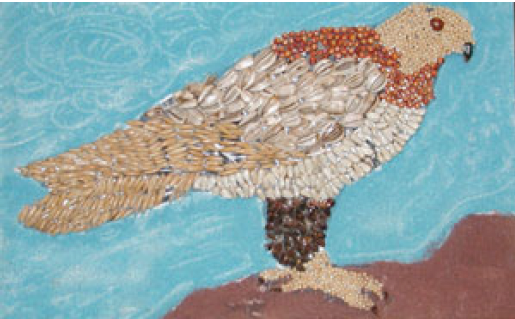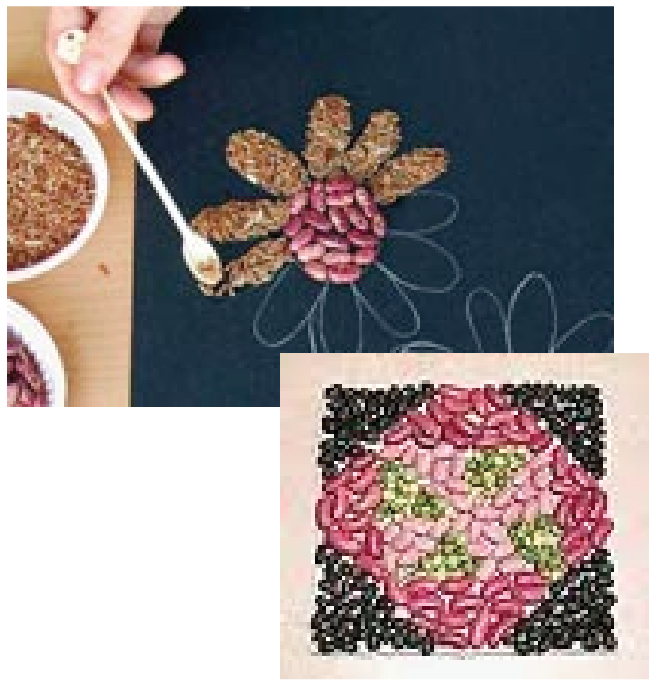Background Agricultural Connections
This lesson uses the garden as a setting for integrating the art concept of texture with life science standards. In the visual arts, texture is the perceived surface quality of a piece of art. For example, a piece of art can look smooth and glossy or rough and bumpy. Sometimes a piece of art that looks rough and bumpy will feel smooth to the touch because the artist has made our eyes perceive a texture that our hands can’t feel. Use of texture, along with other elements of design, can convey a variety of messages and emotions. In the garden, a variety of textures can be observed and felt.
A garden is also a great place to explore the differences between living and nonliving things and the connections between them. Living plants and bugs abound in the garden, as do nonliving rocks. The mineral component of the soil is nonliving, but a handful of soil contains many living creatures, most of which are too small for us to see. Soil organisms and plant roots depend on the nonliving components of the soil for nutrition (minerals like potassium and calcium come from weathering of rocks) and habitat (soil protects roots, holds water and air, and provides a home for many worms and insects). When plants die, they decompose and become part of the soil as organic matter. Organic matter is an important component of healthy soil. It helps the soil hold air and water that plant roots and other soil organisms need.
Living things have characteristics that differentiate them from nonliving things. Living things grow, move, and reproduce; nonliving things do not. Plants are some of the most important living players in the garden. They provide us with vegetables and fruits as well as beautiful flowers, leaves, and textures. On farms, plants are very important, providing food for both people and animals. Although plants can’t walk, run, or jump, they do move, turning leaves toward the sun, curling tendrils around trellises, and opening and closing flowers. In order to live and grow, plants need light, air, water, and nutrients, all of which are nonliving.
 Tell the students that they will be creating seed and soil mosaics to go along with some of the items they have collected. They will use their living and nonliving items to create a piece of art and explore a wide variety of textures. Define texture and explain that it is an important component of art that can be used to create different messages and emotions for the person viewing the artwork. Ask the students to identify the two senses we use to perceive texture (sight and touch), and discuss how the texture of a piece of art does not always feel the way it looks.
Tell the students that they will be creating seed and soil mosaics to go along with some of the items they have collected. They will use their living and nonliving items to create a piece of art and explore a wide variety of textures. Define texture and explain that it is an important component of art that can be used to create different messages and emotions for the person viewing the artwork. Ask the students to identify the two senses we use to perceive texture (sight and touch), and discuss how the texture of a piece of art does not always feel the way it looks. Instruct students to glue the large items on the mosaic first and add the seeds and dry soils next. All items should be attached with plenty of white glue. It is best if glue is applied to the lines of the design which have been traced onto the background, working with small areas at a time. Better results will be obtained if an area is left to dry before proceeding. Keep glue off of the surfaces where no seeds will be applied. Once the glue is dry, avoid flexing the paper plate.
Instruct students to glue the large items on the mosaic first and add the seeds and dry soils next. All items should be attached with plenty of white glue. It is best if glue is applied to the lines of the design which have been traced onto the background, working with small areas at a time. Better results will be obtained if an area is left to dry before proceeding. Keep glue off of the surfaces where no seeds will be applied. Once the glue is dry, avoid flexing the paper plate.